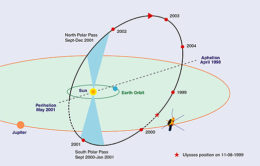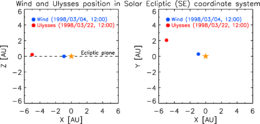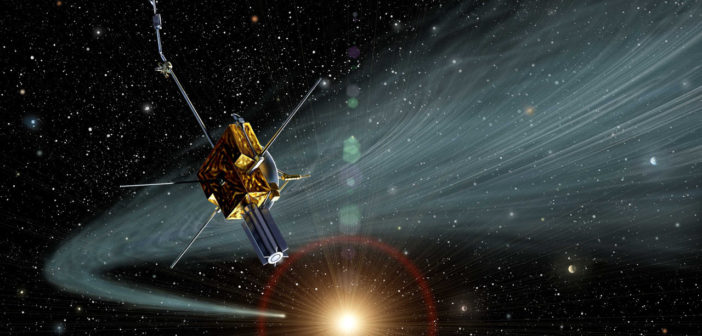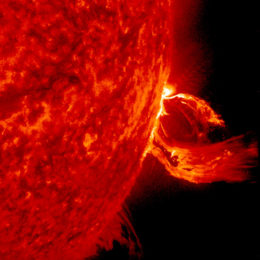In March of 1998, a mass of plasma erupted from the Sun. As it sped out into interplanetary space, two spacecraft were perfectly situated to measure this dramatic cloud. Now, more than 20 years later, we’re still benefitting from their fortuitous alignment.
Interplanetary Journeys
Coronal mass ejections (CMEs), violent releases of plasma and magnetic fields from the Sun’s atmosphere, are by no means rare! When the Sun is at its most active, several CMEs can occur each day — and some of these ejections are so energetic that they travel great distances through our solar system, carrying embedded clouds wrapped in helical magnetic fields.
But what happens to these magnetic clouds as they journey through interplanetary space? Do they expand, unperturbed, as they travel? Or do they interact with other magnetic solar phenomena — like additional CMEs, or the solar wind — and change their shapes or behaviors?
A Fortuitous Alignment

The Ulysses spacecraft orbits on an elliptical trajectory out of the plane of the ecliptic, so its near-perfect alignment with Wind at the time of the CME was lucky! [NASA]
While a number of past and current spacecraft have the ability to measure the properties of the solar wind and magnetic fields around them, the vast majority of these spacecraft orbit close to the Sun (at or within 1au distance). In 1998, however, we got lucky: the only wide-orbit spacecraft devoted to solar wind studies, Ulysses, just happened to be radially aligned with a close-in spacecraft, Wind, when a CME was launched in their direction.
The two spacecrafts’ observations of the resulting magnetic cloud have now been re-examined in a study led by Daniele Telloni (INAF Astrophysical Observatory of Turin, Italy).
Colliding Clouds
The magnetic cloud contained in this interplanetary CME arrived at Wind, which orbits at 1 au, in early March of 1998. 18 days later, the cloud arrived at Ulysses, which happened to be in line at the time at 5.4 au (out at Jupiter’s orbit). Telloni and collaborators conducted new analysis of Ulysses’s and Wind’s combined data sets for the interplanetary magnetic field and the solar wind plasma during the magnetic cloud’s passage of the two spacecraft.

Alignment of Wind (blue) and Ulysses (red) with respect to the Sun (yellow star) in March 1998. [Telloni et al. 2020]
This valuable insight was made possible due to two spacecraft being aligned at the right time — so what are the chances of similar good luck in the future? With the wealth of recently launched planetary and solar missions like BepiColombo, Solar Orbiter, and Parker Solar Probe, odds are good for future radial alignments that will allow us to further measure ejections from the Sun.
Citation
“Magnetohydrodynamic Turbulent Evolution of a Magnetic Cloud in the Outer Heliosphere,” Daniele Telloni et al 2020 ApJL 905 L12. doi:10.3847/2041-8213/abcb03


3 Comments
Pingback: Measuring Solar Eruptions with a Rare Alignment – Sky & Telescope – §Framework Info§
Pingback: Measuring Solar Eruptions with a Rare Alignment - Sky & Telescope – TheLife247
Pingback: Measuring Solar Eruptions with a Rare Alignment - Sky & Telescope - Space Force